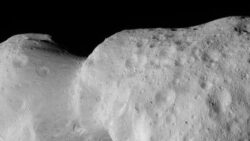NASA’s Lucy Mission Captures First Image of Giant Asteroid
NASA’s Lucy mission has achieved a remarkable milestone by capturing the first detailed images of a massive, peanut-shaped asteroid named Dinkinesh. This giant asteroid, located in the main asteroid belt between Mars and Jupiter, revealed a surprising and complex shape that offers scientists new insights into the formation and evolution of such celestial bodies. The photos were taken as Lucy made a close flyby of Dinkinesh, marking the mission’s first major encounter since its launch in 2021.
What makes this discovery particularly fascinating is the asteroid’s unexpected shape — resembling a peanut or two lobes fused together. This suggests that Dinkinesh may have formed from a slow collision or a gravitational merger of two separate objects, a theory consistent with what scientists call a “contact binary.” These types of asteroids are rare and studying them can help researchers understand the building blocks of planets and the early dynamics of the solar system.
The Lucy mission, named after the famous fossil that helped illuminate human evolution, is designed to explore Jupiter’s Trojan asteroids — ancient remnants of the solar system. However, this first encounter with Dinkinesh serves as a crucial test of Lucy’s systems and instrumentation, while also delivering unexpected scientific dividends. As the spacecraft continues its journey, NASA and the global scientific community are eagerly anticipating even more groundbreaking discoveries.




